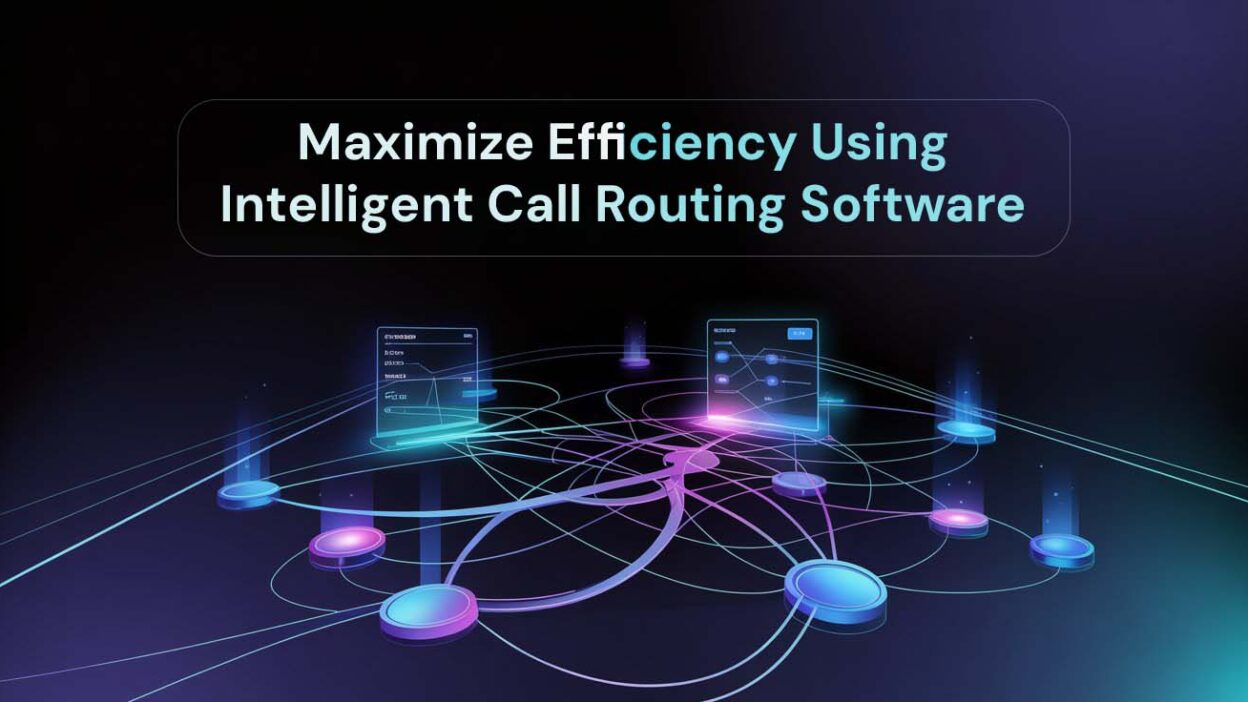TL;DR Picture this: It’s Monday morning, and your intelligent call routing software is nowhere to be found. Your phone system is overwhelmed, customers are waiting on hold, frustrated voices are escalating, and your best agents are buried under routine inquiries while complex issues pile up in the queue. Sound familiar?
Table of Contents
You’re not alone. Thousands of businesses face this exact scenario every day, watching productivity nosedive and customer satisfaction suffer, all because their systems lack the power of automatic call distribution (ACD).
Real-time call routing isn’t just another tech buzzword. It’s a transformative tool that understands your business needs and adapts in real time. It ensures every caller reaches the right person, right away, turning chaos into control and frustrated customers into loyal fans.
Today, we’re diving deep into how AI-powered phone management systems, and especially call flow optimization, can elevate your customer experience from reactive firefighting to proactive service excellence.
The Hidden Cost of Inefficient Call Management
Before we explore the solution, let’s talk about what inefficient call management is costing your business. And trust me, it’s more than you think.
The Real Numbers Behind Poor Call Routing
Most businesses lose about 23% of potential revenue simply because calls aren’t reaching the right person at the right time. That’s not just a statistic; that’s your mortgage payment, your employees’ bonuses, your growth capital disappearing into thin air.
Consider Sarah, a marketing director at a growing SaaS company. Her team was spending 40% of their time on calls that should have gone to customer support, while support was handling sales inquiries they weren’t equipped to close. The result? Longer resolution times, missed sales opportunities, and a team that was burning out fast.
The Domino Effect of Manual Call Handling For Intelligent Call Routing Software
When you’re manually routing calls or using basic phone systems, you’re creating a domino effect of inefficiency:
- Customer Frustration: Nobody likes being transferred three times to get a simple question answered. Each transfer is another opportunity for them to hang up and call your competitor.
- Agent Burnout: Your skilled agents become glorified call transfer operators instead of problem-solvers. They’re not using their expertise; they’re playing phone tag.
- Revenue Leakage: Every misrouted call is potential revenue walking out the door. A sales call that ends up in technical support rarely converts.
- Operational Chaos: Without proper routing, you can’t predict call volumes, staff appropriately, or measure performance accurately.
This is where call flow optimization becomes not just helpful, but essential for business survival.
What Makes Intelligent Call Routing Software Different
Traditional call routing is like using a road map from 1995 to navigate today’s traffic. It might get you there eventually, but you’ll waste time, fuel, and patience along the way.
Beyond Basic Call Distribution
Standard call systems use simple rules: “If it’s during business hours, send it to queue A. If not, send to voicemail.” That’s not routing; that’s just basic sorting.
Intelligent call routing software operates on an entirely different level. It analyzes multiple data points simultaneously:
- Caller Intent: What does the customer need?
- Agent Expertise: Who’s best equipped to handle this specific inquiry?
- Historical Data: What worked for similar calls in the past?
- Real-time Metrics: Who’s available, and what’s their current workload?
- Business Priority: Is this a high-value customer or a potential sale?
The AI Advantage in Intelligent Call Routing Software
Here’s where AI transforms everything. Instead of following rigid rules, omnichannel support learns and adapts. It recognizes patterns humans miss and makes connections that traditional systems can’t.
For example, if a customer calls about a billing issue but their account shows recent technical problems, the AI might route them to a technical specialist who can address both issues in one call. That’s not just efficiency; that’s customer experience magic.
Core Features For Intelligent Call Routing Software
Not all omnichannel support is created equal. The systems that actually move the needle share specific features that separate them from basic call forwarding tools.
Real-Time Decision Making For Intelligent Call Routing Software
The best intelligent call routing software doesn’t just route calls; it makes good decisions in milliseconds. While traditional systems follow predetermined paths, AI-powered routing evaluates dozens of variables instantly.
- Dynamic Queue Management: Instead of static queues that back up during busy periods, intelligent systems create dynamic routing paths that adapt to current conditions.
- Predictive Routing: Advanced systems don’t just react to current call volume; they predict patterns and adjust routing before problems develop.
- Context-Aware Matching: The software understands not just who’s available, but who’s most qualified for each specific call type.
Integration Capabilities For Intelligent Call Routing Software
Standalone intelligent call routing software is like having a sports car engine in a bicycle frame, impressive technology that can’t reach its potential. The most effective systems integrate seamlessly with your existing business tools.
- CRM Integration: When your routing software knows a customer’s history, preferences, and value, it can make smarter routing decisions. A VIP customer with a technical issue might bypass the general queue entirely.
- Analytics Platforms: Real-time data flows into your business intelligence tools, giving you insights that drive continuous improvement.
- Communication Channels: Modern omnichannel support doesn’t just handle voice calls. It routes emails, chats, and social media inquiries through the same intelligent system.
Scalability Without Complexity
One of the biggest mistakes businesses make is choosing IVR systems (Interactive Voice Response) that works for their current size but breaks under growth pressure. Smart systems scale elegantly.
- Flexible Routing Rules: As your business grows and changes, your routing rules should adapt without requiring complete system overhauls.
- Multi-Location Support: Whether you have one office or fifty, intelligent call routing software should handle complex, multi-site routing seamlessly.
- Peak Load Management: The system should handle holiday rushes and unexpected call spikes without degrading performance.
Implementation Strategies
Having great intelligent call routing software is only half the battle. Implementation separates successful deployments from expensive mistakes. Here’s how to do it right.
Phase 1: Assessment and Planning
Before you configure a single routing rule, you need to understand your current call patterns deeply. Most businesses think they know how their calls flow, but the reality often surprises them.
- Call Pattern Analysis: Spend at least two weeks analyzing your current call data. When do calls peak? What types of inquiries are most common? Where do transfers happen most frequently?
- Agent Skill Mapping: Create detailed profiles of your team’s capabilities. Sarah might be excellent with technical issues, but struggles with billing disputes. Mark might close sales calls effectively but get flustered with complex support requests.
- Business Priority Definition: Not all calls are equal. A potential enterprise sale deserves a different routing than a general inquiry. Define your priority hierarchy clearly.
Phase 2: Intelligent Configuration
This is where most intelligent call routing software implementations succeed or fail. The key is starting simple and building complexity gradually.
- Start with Basic AI Rules: Begin with fundamental routing based on time of day, agent availability, and basic call type detection. Get these working perfectly before adding advanced features.
- Implement Feedback Loops: Your intelligent call routing software should learn from outcomes. If certain routing decisions consistently lead to transfers or escalations, the system should adjust automatically.
- Test Everything: Use call simulation tools to test your routing logic under various scenarios. What happens during peak hours? How does the system handle simultaneous high-priority calls?
Phase 3: Team Training and Adoption
Even the smartest intelligent call routing software can’t compensate for untrained users. Your team needs to understand not just how to use the system, but how to work with it effectively.
- Agent Education: Help your team understand how the AI makes routing decisions. When they know why certain calls come to them, they can provide better feedback to improve the system.
- Management Training: Supervisors need to understand the analytics and reporting features to make data-driven decisions about routing optimization.
- Continuous Learning: Schedule regular training sessions as you add new features or refine routing rules.
Measuring Success: KPIs That Matter
Implementing intelligent call routing software without proper measurement is like driving with your eyes closed. You might get somewhere, but you won’t know if it’s where you wanted to go.
Customer Experience Metrics
- First Call Resolution Rate: This is the gold standard. How often do customers get their issues resolved on the first call? Intelligent call routing software should dramatically improve this metric by connecting customers with the right agent immediately.
- Average Handle Time: While speed isn’t everything, efficient routing should reduce the time agents spend on each call by eliminating confusion and transfers.
- Customer Satisfaction Scores: The ultimate test of your intelligent call routing software is whether customers notice the improvement. Survey scores should reflect better experiences.
Operational Efficiency Indicators
- Transfer Rate: One of the clearest indicators of routing effectiveness is how often calls get transferred. Great intelligent call routing software should reduce transfers by 60-80%.
- Agent Utilization: Are your skilled agents spending time on tasks that match their expertise? Proper routing should increase the percentage of time agents spend on calls they’re uniquely qualified to handle.
- Queue Abandonment Rate: How many callers hang up before reaching an agent? Effective routing reduces wait times and abandonment rates.
Business Impact Measurements
- Revenue Per Call: Not all calls generate revenue, but intelligent call routing software should increase the conversion rate of sales calls and reduce the cost of support calls.
- Cost Per Resolution: Calculate the total cost of resolving customer issues. Better routing should reduce this by connecting customers with agents who can solve problems faster.
- Employee Satisfaction: Happy agents provide better customer service. Measure whether your team feels more effective and less frustrated after implementing intelligent call routing software.
Advanced Features for Competitive Advantage
Once you’ve mastered the basics of intelligent call routing software, advanced features can provide significant competitive advantages.
Predictive Analytics Integration
The most sophisticated intelligent call routing software doesn’t just react to current conditions, it predicts future needs and adjusts accordingly.
- Call Volume Forecasting: AI analyzes historical patterns, seasonal trends, and external factors to predict call volumes hours or days in advance. This enables proactive staffing adjustments.
- Agent Performance Prediction: The system learns which agents perform best under different conditions and routes calls accordingly. Sarah might excel during busy periods, while Mark performs better with complex, time-intensive issues.
- Customer Behavior Modeling: Advanced systems track customer interaction patterns and predict likely call reasons before customers even dial.
Omnichannel Intelligence
Modern customers don’t just call, they email, chat, and message across multiple platforms. The best intelligent call routing software extends its intelligence across all channels.
- Cross-Channel Context: If a customer starts with a chat inquiry and then calls, the AI should route the call to an agent who understands the full context.
- Channel Optimization: The system learns which channels work best for different types of inquiries and can suggest optimal communication methods to customers.
- Unified Agent Experience: Agents see complete customer interaction history regardless of channel, enabling more effective problem resolution.
AI-Powered Quality Assurance
Intelligent call routing software can do more than just route calls; it can help ensure quality throughout the interaction.
- Real-Time Coaching: The AI can provide real-time suggestions to agents during calls, helping them handle complex situations more effectively.
- Automatic Quality Scoring: Instead of manually reviewing random calls, the system can automatically score all interactions and highlight those needing human review.
- Compliance Monitoring: For regulated industries, the AI can monitor calls for compliance issues and alert supervisors to potential problems immediately.
Industry-Specific Applications
Different industries have unique challenges that intelligent call routing software can address with specialized approaches.
Healthcare: Patient-Centric Routing
Healthcare organizations using intelligent call routing software report significant improvements in patient satisfaction and operational efficiency.
- Urgency Assessment: The AI can assess the urgency of health-related calls and route emergencies to appropriate medical staff immediately.
- Specialist Matching: Complex medical inquiries get routed to healthcare providers with relevant expertise, reducing callback needs and improving patient outcomes.
- Appointment Optimization: The system can handle routine appointment scheduling automatically while routing complex scheduling requests to human agents.
Financial Services: Security-First Routing
Financial institutions require intelligent call routing software that balances efficiency with security and compliance requirements.
- Fraud Detection Integration: Suspicious call patterns trigger enhanced verification procedures and routing to specialized fraud teams.
- Regulatory Compliance: Calls involving regulated financial products automatically route to properly licensed agents with compliance monitoring.
- High-Value Customer Prioritization: VIP customers and high-balance accounts receive priority routing to experienced relationship managers.
E-commerce: Sales-Optimized Routing
Online retailers use intelligent call routing software to maximize conversion rates and minimize support costs.
- Purchase Intent Detection: The AI identifies calls with high sales potential and routes them to top-performing sales agents.
- Order Status Automation: Routine order inquiries get handled automatically, freeing agents for complex customer service issues.
- Return Prevention: Calls about returns or cancellations route to retention specialists trained to resolve issues and save sales.
ROI Analysis: The Numbers That Matter
Investing in intelligent call routing software requires justification, and the ROI can be substantial when measured correctly.
Direct Cost Savings
- Reduced Agent Requirements: Efficient routing typically allows businesses to handle 20-30% more calls with the same number of agents, or maintain service levels with fewer staff.
- Lower Training Costs: When agents handle calls matching their expertise, onboarding time decreases, and ongoing training needs are reduced.
- Decreased Technology Overhead: Modern intelligent call routing software often replaces multiple legacy systems, reducing licensing and maintenance costs.
Revenue Enhancement
- Increased Sales Conversion: Better routing of sales calls to qualified agents can improve conversion rates by 15-25%.
- Reduced Customer Churn: Faster resolution and better experiences reduce cancellation rates, directly impacting recurring revenue.
- Upselling Opportunities: When agents have complete customer context, they can identify and capitalize on additional sales opportunities.
Productivity Multipliers
- Management Efficiency: Automated routing reduces the time supervisors spend manually managing call distribution, allowing focus on coaching and strategy.
- Data-Driven Decisions: Rich analytics from intelligent call routing software enable better business decisions across departments.
- Scalability Benefits: The system grows with your business without proportional increases in management overhead.
Future-Proofing Your Investment
Technology evolves rapidly, and intelligent call routing software investments should provide value for years to come.
Emerging Technology Integration
- Voice AI Advances: Next-generation intelligent call routing software will integrate with increasingly sophisticated voice AI, enabling more nuanced caller intent detection.
- Predictive Customer Service: AI will anticipate customer needs and proactively reach out with solutions before issues become problems.
- Emotional Intelligence: Future systems will detect customer emotions and adjust routing accordingly, ensuring frustrated customers reach empathetic agents.
Regulatory Compliance Evolution
- Privacy Regulations: As data privacy laws evolve, intelligent call routing software must adapt to new requirements while maintaining effectiveness.
- Industry Standards: Compliance requirements in healthcare, finance, and other regulated industries continue expanding, requiring flexible, adaptive systems.
- International Considerations: Global businesses need intelligent call routing software that handles varying regulatory requirements across jurisdictions.
Business Model Adaptation
Remote Work Integration: Post-pandemic work models require intelligent call routing software that seamlessly manages distributed agent teams.
Gig Economy Agents: Some businesses are experimenting with on-demand agent pools, requiring dynamic routing capabilities.
AI-Human Collaboration: Future systems will blur the lines between human and AI agents. It require sophisticated routing decisions about when and how to involve human expertise.
Choosing the Right Intelligent Call Routing Software
With numerous options available, selecting the right intelligent call routing software requires careful evaluation of your specific needs and circumstances.
Essential Evaluation Criteria
Scalability Architecture: Can the system handle your growth projections without performance degradation? Look for cloud-native solutions that scale elastically.
Integration Ecosystem: How well does the intelligent call routing software work with your existing CRM, helpdesk, and business intelligence tools?
Customization Flexibility: Every business has unique routing needs. The system should allow custom rules without requiring extensive programming.
Vendor Support Quality: Implementation and ongoing support quality often determines success more than feature lists.
Red Flags to Avoid
Over-Complicated Interfaces: If the system requires extensive training for basic operation, it will face adoption resistance and increase operational overhead.
Vendor Lock-In: Avoid intelligent call routing software. It makes difficulty to export data or switch systems.
Unrealistic Promises: Be skeptical of vendors claiming 100% automation or perfect AI performance. Effective systems augment human capabilities.
Poor Documentation: Comprehensive documentation and training resources indicate vendor commitment to customer success.
Implementation Timeline Planning Phases
Weeks 1-2: System setup, basic configuration, and agent training on core features.
3-4: Advanced routing rule implementation and integration with existing systems.
5-8: Performance optimization, feedback incorporation, and team workflow refinement.
Ongoing: Continuous monitoring, rule refinement, and feature expansion based on business needs.
Making the Investment Decision
Implementing intelligent call routing software represents a significant investment in your business’s future. The decision should be based on clear ROI projections and strategic alignment with business goals.
Cost-Benefit Analysis Framework
- Current State Assessment: Document your existing call handling costs, including agent salaries, technology expenses, and lost opportunity costs from poor routing.
- Projected Improvements: Based on vendor demonstrations and case studies, estimate realistic improvements in key metrics like first call resolution and average handle time.
- Implementation Costs: Include software licensing, implementation services, training, and ongoing support in your total cost calculations.
- Payback Period Calculation: Most businesses see positive ROI from intelligent call routing software within 6-12 months, with benefits accelerating over time.
Risk Mitigation Strategies
Pilot Programs: Start with a limited implementation to prove ROI before full deployment.
Vendor References: Speak with current customers in similar industries to understand real-world performance and challenges.
Contractual Protections: Ensure contracts include performance guarantees and implementation milestones with penalties for non-delivery.
Change Management Planning: The best intelligent call routing software fails without proper change management. Plan for organizational adaptation from the beginning.
Conclusion

The businesses thriving in today’s competitive landscape aren’t necessarily the ones with the best products or lowest prices. They’re the ones providing exceptional customer experiences consistently. They’re the ones where calling for help helps, where customers feel understood and valued, where problems get solved rather than shuffled around.
The companies that implement intelligent call routing software today will dominate their markets tomorrow. The ones that wait will be playing catch-up, wondering how their competitors suddenly became so much better at customer service.
Customers are calling. Agents are waiting. Your opportunity is now.
The only question left is: What are you going to do about it?






[…] enable businesses to conduct perfect and individual interactions with their customers. One of the Best AI Tools is the ability to establish both single and batch calls, providing flexibility and convenience for […]
[…] assistance, and controlling smart devices. While the technology is constantly improving, current AI voice call systems still have some limitations in handling difficult or delicate requests compared to […]
[…] sure, now better as individuals. It will create tech knot bonds within society, which will one day lead to a time when meaningful connections will be more of a rule than an […]
[…] the fast-paced world of real estate, lead conversion is a critical factor in determining success. Many businesses struggle with slow response times, […]
[…] Read More: Maximize Efficiency Using Intelligent Call Routing Software […]
[…] Custom voice AI models enhance legal practice efficiency. Voice recognition accuracy reaches 98% for legal terms. Document preparation time decreases by 40%. Client service quality improves through faster response times. […]
[…] Read More: Maximize Efficiency Using Intelligent Call Routing Software […]
[…] Read More: Maximize Efficiency Using Intelligent Call Routing Software […]